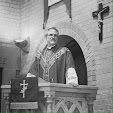Friday, April 16, 2010
Confederate History Moment Twofer
Lost amid all the self-serving politically-correct propaganda masquerading as history that is being taught in American government schools is the story of black Southerners, free and slave, who took part in the Confederate States war effort to defend their families, homes, and country. This was as natural and inevitable as the (also largely overlooked) black Americans who took part in the war effort of the first American war of secession of 1775-1783.
My friend H.K. Edgerton talks the talk and walks the walk (in one case, walking from Asheville, NC to Austin, TX carrying a Confederate battle flag) to explain to anyone who will listen that his family took an active and courageous part in the war to repel northern invaders during the second American war of secession of 1861-1865.
When the United Confederate Veterans (UCV) met in reunions after the war, there were always black veterans who took part. They were not segregated - unlike their northern counterparts in the Grand Army of the Republic (GAR) - whose black veterans were housed in separate camps. This caused some consternation in the joint GAR-UCV reunion in Gettysburg in 1913 on the 50th anniversary of the battle, when black Confederate veterans showed up, and Union veterans were stunned that they were not placed into separate quarters like the blacks who wore the blue.
To those who actually live in the South (and not just read about it in books), this is not surprising at all. In spite of our bumpy history (much of which was fueled by poverty and Jim Crow that were both legacies from the fallout of the war and reconstruction), black and white Southerners have a long and shared history of personal interaction and mutual hardship that seems inconceivable to those who need a myth of hatred to fuel their own political and academic careers.
Those interested in the truth will get it, and those who don't will continue to cling to their convenient mythology.
Labels:
education,
History,
Music,
political correctness,
Southern heritage
Subscribe to:
Post Comments (Atom)

No comments:
Post a Comment